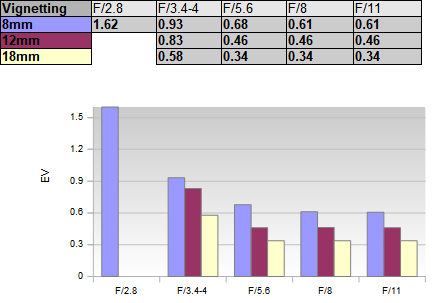|
Panasonic Leica DG Vario-Elmarit 8-18mm f/2.8-4 ASPH - Review / Test Report - Analysis |
|
Lens Reviews -
(Micro-)Four-Thirds
|
|
Page 2 of 3

Distortion
The distortion characteristic follows the usual pattern of MFT lenses in this class. Thus in real-life, you won't notice any substantial
distortions. At 8mm there are visible traces of barrel distortions (1.4%) but it's a non-issue at 12mm and 18mm really.
The native characteristic of the lens is very different though. If you disable image auto-correction, there's an extreme amount of barrel distortions
at 8mm (6.6%). The more you zoom out, the fewer distortions are apparent though. At 12mm, they are down to a moderate 2.4% and they are gone at 18mm.
Vignetting
Image auto-correction is also active with respect to vignetting. Normally you can just point and shoot without caring about light falloff - at around 0.5EV (f-stops) you will barely notice this.
 The situation is once again different when looking at the raw image albeit it remains within the common boundaries of lenses in this class.
The vignetting is worst at 8mm f/2.8 (unsurprisingly) with a light falloff of 1.6EV (f-stops) and that's clearly noticeable. Most of the vignetting is gone
from f/5.6 onward though. At 12mm the issue is substantially reduced. You may still spot some vignetting at f/3.4 but from f/5.6 it's already
rather irrelevant. The characteristic is very moderate at 18mm.
The situation is once again different when looking at the raw image albeit it remains within the common boundaries of lenses in this class.
The vignetting is worst at 8mm f/2.8 (unsurprisingly) with a light falloff of 1.6EV (f-stops) and that's clearly noticeable. Most of the vignetting is gone
from f/5.6 onward though. At 12mm the issue is substantially reduced. You may still spot some vignetting at f/3.4 but from f/5.6 it's already
rather irrelevant. The characteristic is very moderate at 18mm.

MTF (resolution)
The most important question of them all is, of course - how sharp is it? It's sharp - mostly at least. The quality of the image center is excellent at all mainstream setting at the wide end of the range. The borders are generally good to very good and the corners reach good levels. As mentioned in previous reviews, it is likely that the image auto-correction is a limiting factor. Compensating a distortion of 6.6% is reducing the corner sharpness due to the amount of image stretching that is required here. The corners are slightly improved at 12mm while the general characteristic remains intact. The center quality is marginally reduced at 18mm although the borders/corners are actually better here compared to the wider settings. As usual, you shouldn't stop down beyond f/8 because diffraction effects will have a negative impact on the image quality.
The centering quality of the tested sample was good albeit not great. Field curvature is noticeable in the mid-range (which is a little odd). In certain scenes, this will introduce a bit of softness in the corners.
Please note that the MTF results are not directly comparable across the different systems!
Below is a simplified summary of the formal findings. The chart shows line widths per picture height (LW/PH) which can be taken as a measure for sharpness.
If you want to know more about the MTF50 figures you may check out the corresponding Imatest Explanations

Chromatic Aberrations (CAs)
Lateral CAs are very low and nothing to worry about.

|